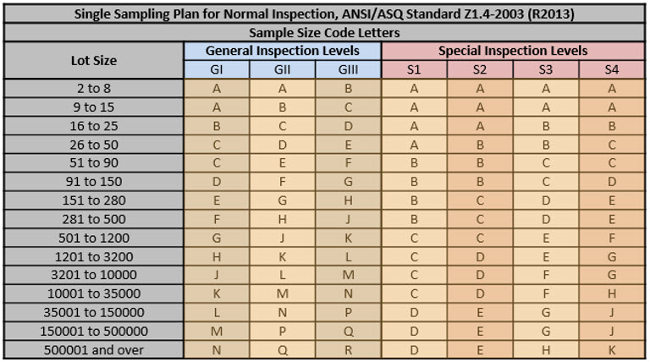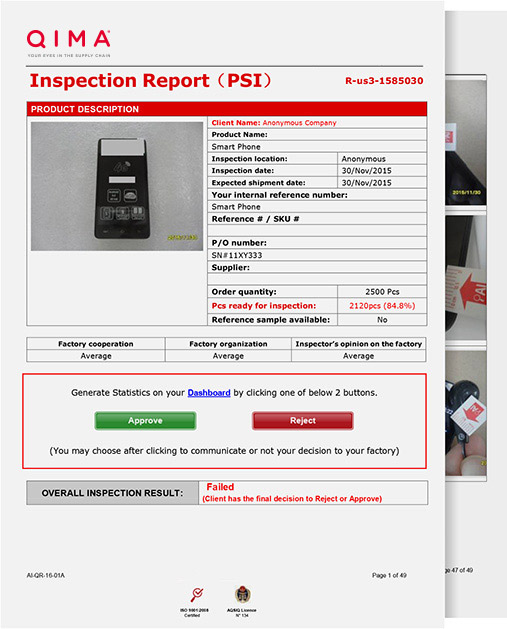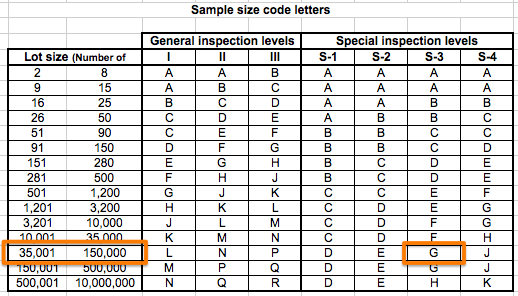
Iso 2500 Sampling Plan Pdf. 4/12/2019 0 Comments Sampling Inspection Procedures, Part 1: Attribute Sampling Plans Indexed by Acceptable Quality Limit (AQL) for Lot-by.
- = Use first sampling plan below the arrow. If sample size equals, or exceeds, lot or batch size, do 100% inspection. = Use first sampling plan above the arrow. 1.5 2.5 4 6.5 10 15 Acceptable Quality Levels (Normal Inspection) e e er e ze 0.065 0.1 0.15 0.25 0.4 0.65 1 AQL CHART www.asiaqualityfocus.com.
- Audit Sampling Steps. Annex A.6.1 provides steps for audit sampling – Establish the objectives of the sampling plan – Select the population to be sampled – Select the sampling method. Judgement or Statistical – Determine the sample size – Conduct the sampling – Compile, evaluate, document, and report the results.
- 11:00 Acceptance Sampling. Sampling Plan Variables - Sample Size - AQL and UQL. Common Standards - ANSI/ASQ Z1.4 - ISO 2859 12:00 Inspector Selection and Qualification. Vision Screening. Initial Training. Initial Qualification. Requalification 12:30 Lunch Break 13:30 Inspection Strategies. Reinspection. 2-Stage Inspection.
- Sep 06, 2013 Manual on Basic Principles of Lot Sampling Itemized lot sampling: IS 2500-1 (pdf) IS 2500-1 (txt) 2000: Sampling Inspection Procedures, Part 1: Attribute Sampling Plans Indexed by Acceptable Quality Limit (AQL) for Lot-by-Lot Inspection: ISO 186: 1985 ISO 2859-1: IS 2500-2 (pdf) IS 2500-2 (txt) 1965.
Attribute sampling is defined as the method of measuring quality that consists of noting the presence (or absence) of some characteristic (attribute) in each of the units under consideration and counting how many units do (or do not) possess it. However, sampling systems are not restricted to attributes. They may be composed of variable plans as well. The difference lies with the measurement data utilized.
Acceptance sampling plans indicate the sampling sizes and associated acceptance or non-acceptance criteria to be used.
- In attributes sampling, there are single, double, multiple, sequential, chain, and skip-lot sampling plans that measure discrete data, such as the number of defects.
- In variables sampling, there are single, double, and sequential sampling plans that measure continuous data, such as time, volume, and length.
The most commonly used form of acceptance sampling is sampling plans by attributes. This inspection method is generally used for two purposes:
- Protection against accepting lots from a continuing process whose average quality deteriorates beyond an acceptable quality level.
- Protection against isolated lots that may have levels of nonconformances greater than can be considered acceptable.
The most widely used standard for attributes sampling plans is ANSI/ASQ Z1.4, but this standard can also be used as the first approach.
Approaches to Process Monitoring: Attribute Sampling Plan (ANSI/ASQ Z1.4)
ANSI/ASQ Z1.4: Sampling Procedures and Tables for Inspection by Attributes
In “Comparing Acceptance Sampling Standards, Part 1,” Dean V. Neubauer and Stephen N. Luko describe ANSI/ASQ Z1.4: Sampling Procedures and Tables for Inspection by Attributes as an American national standard with direct lineage to MIL-STD-105E, a military standard that describes the sampling procedures and tables for inspection by attributes. When the U.S. Department of Defense stopped supporting MIL-STD-105E in 1995, it recommended ANSI/ASQ Z1.4 as the replacement.
The Z1.4 standard is similar in format to both MIL-STD-105E and ASTM E2234-09: Standard Practice for Sampling a Stream of Product by Attributes Indexed by AQL. However, it differs in its definition of what constitutes a rejectable item. Best used in-house and in domestic transactions, ANSI/ASQ Z1.4 employs definitions and terminology in accordance with ANSI/ISO/ASQ 3534-2:2006: Statistics – Vocabulary and Symbols – Part 2, Applied Statistics.
The following two definitions are particularly important in applying the standard:

- Defect: A departure of a quality characteristic from its intended level or state that occurs with a severity sufficient to cause an associated product or service not to satisfy intended normal or foreseeable usage requirements.
- Nonconformity: A departure of a quality characteristic from its intended level or state that occurs with severity sufficient to cause an associated product or service not to meet a specification requirement.
ANSI/ASQ Z1.4 presents acceptance sampling plans for attributes in terms of the percentage or proportion of product in a lot or batch that departs from some requirement. The general terminology used in the standard is given in terms of percentage of nonconforming units or number of nonconformities because these terms are likely to constitute the most widely used criteria for acceptance sampling.
ANSI/ASQ Z1.9: Sampling Procedures and Tables for Inspection by Variables for Percent Nonconforming
According to Neubauer and Luko’s “Comparing Acceptance Sampling Standards, Part 2,” ANSI/ASQ Z1.9: Sampling Procedures and Tables for Inspection by Variables for Percent Nonconforming represents an effort to unify variables and attributes sampling systems.
The Z1.9 standard provides a reasonable match between a modified MIL-STD-414, offering sampling procedures and tables for inspection by variables and for percent defective, and MIL-STD-105. Other changes included making the inspection levels coincide between the two standards, adopting the switching rules and lot size ranges of MIL-STD-105, and making editorial changes as appropriate.
Sampling Plan In Marketing Research
Given the lot size and acceptance quality limit (AQL), moving between the two standards with the same code letter and AQL is possible. The procedures and structure of ANSI/ASQ Z1.9 are essentially the same as for MIL-STD-414. The set of examples in MIL-STD-414 has been retained and leads the user through application of the Z1.9 standard.
The ANSI/ASQ Z1.9 standard is an excellent vehicle for in-house use and stands as the national standard to be employed internally in the United States.
Sampling by Variables
Variables sampling plans use the actual measurements of sample products for decision making rather than classifying products as conforming or nonconforming, as in attributes sampling plans. Variables sampling plans are more complex in administration than attributes plans, thus, they require more skill. They provide some benefits, however, over attributes plans. Two of these benefits are:
- Equal protection to an attributes sampling plan but with a much smaller sample size. There are several types of variables sampling plans in use, including: (1) known, (2) unknown but can be estimated using sample standard deviations, and (3) unknown and the range R is used as an estimator.
- If an attributes sampling plan sample size is determined, the variables plans previously listed can be compared as a percentage to the attributes plan.
- Variables sampling plans allow the determination of how close to nominal or a specification limit the process is performing. Attributes plans either accept or reject a lot; variables plans give information on how well or poorly the process is performing.
Variables sampling plans, such as ANSI/ASQ Z1.9, have some disadvantages and limitations:
- The assumption of normality of the population from which the samples are being drawn.
- Unlike attributes sampling plans, separate characteristics on the same parts will have different averages and dispersions, resulting in a separate sampling plan for each characteristic.
- Variables plans are more complex in administration.
- Variables gauging is generally more expensive than attributes gauging.
The most common standard for variables sampling plans is ANSI/ASQ Z1.9, which has plans for (1) variability known, (2) variability unknown—standard deviation method, and (3) variability unknown—range method. Using the methods above, this sampling plan can be used to test for a single specification.
History of Sampling Plans & Procedures: Military Standards
Attribute sampling standards date back to the 1930s and the original work of Harold F. Dodge and others at Bell Labs. Today’s attribute standards (ANSI/ASQ Z1.4-2008, ASTM E2234-2009, ISO 2859-1974) find their common heritage in the older Military Standard 105 series. As does today’s variable standards, which evolved from Military Standard 414 (MIL-STD-414 issued on June 11, 1957). It has since become a classic companion standard to MIL-STD-105 and has been used throughout the world.
Military standards came from a need for a sampling system that did not require 100% inspection for use in testing munitions and other destructive tests. The result was the Army Service Forces inspection tables, which came out in 1942 and 1943. Improvement led to MIL-STD-105A, B, C, D, and E (1950, 1958, 1961, 1963, 1989) in subsequent years.
Military standard 105 (MIL-STD-105) is the premier attribute sampling standard that has led to a number of derivative standards. Like MIL-STD-105, MIL-STD-414 has derivative variable standards as well that are in use today. However, the Army discontinued support for military statistical standards on February 27, 1995, proposing instead to use civilian standards.
The primary derivative standard, MIL-STD-105E (1989), is still regarded as a classic system worldwide and is used as the primary comparison when discussing civilian standards. The American National Standards Institute (ANSI), the International Organization for Standardization (ISO), and the International Electrotechnical Commission developed their own derivatives of 105 as civilian standards.
Learn more about ANSI/ASQ Z1.4 & Z1.9

For a more comprehensive discussion of the Z1.4 and Z1.9 standards and their relation to the corresponding military, ASTM, and ISO standards, see the following resources:
- Dean V. Neubauer and Stephen N. Luko's two-part series in Quality Engineering:
- Comparing Acceptance Sampling Standards, Part 1, volume 25, no. 1, January 2013, pages 73-77.
- Comparing Acceptance Sampling Standards, Part 2, volume 25, no. 2, April 2013, pages 181-187.
- Edward G. Schilling and Dean V. Neubauer, Acceptance Sampling in Quality Control, CRC Press, 2009.
What is the Z1.4 Standard?
ANSI/ASQ Z1.4-2003 (R2018): Sampling Procedures and Tables for Inspection by Attributes is an acceptance sampling system to be used with switching rules on a continuing stream of lots for Acceptance Quality Limit (AQL) specified. It provides tightened, normal, and reduced plans to be applied for attributes inspection for percent nonconforming or nonconformities per 100 units.
Iso 2500 Sampling Plan Pdf Format
Example of content in ANSI/ASQ Z1.4
What is the Z1.9 Standard?
ANSI/ASQ Z1.9-2003 (R2018): Sampling Procedures and Tables for Inspection by Variables for Percent Nonconforming is an acceptance sampling system to be used on a continuing stream of lots for Acceptance Quality Limit (AQL) specified. It provides tightened, normal, and reduced plans to be used on measurements which are normally distributed. Variation may be measured by sample standard deviation, sample range, or known standard deviation. It is applicable only when the normality of the measurements is assured.

Example of content in ANSI/ASQ Z1.9

History of Z1.4 & Z1.9
Iso 2500 Sampling Plan Pdf Free
Read an overview on sampling, which describes the origins and purposes of the statistical standards ANSI/ASQ Z1.4, which establishes sampling plans and procedures for inspection by attributes, and ANSI/ASQ Z1.9, which establishes sampling plans and procedures for inspection by variables.